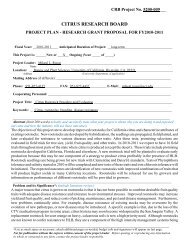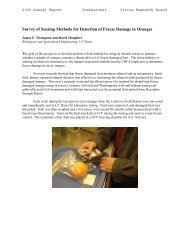Beth Grafton-Cardwell and her team at Lindcove - Citrus Research ...
Beth Grafton-Cardwell and her team at Lindcove - Citrus Research ...
Beth Grafton-Cardwell and her team at Lindcove - Citrus Research ...
Create successful ePaper yourself
Turn your PDF publications into a flip-book with our unique Google optimized e-Paper software.
PACIFIC DISTRIBUTING, INC<br />
Distributor for<br />
Orchard-Rite®<br />
wind machines for<br />
frost protection &<br />
Tropic Breeze®<br />
original parts<br />
Sales<br />
Service<br />
New<br />
Used<br />
Portable<br />
St<strong>at</strong>ionary<br />
24 Hour<br />
Emergency<br />
Service<br />
559-564-3114<br />
Woodlake, CA<br />
www.orchard-rite.com<br />
38 Citrograph July/August 2011<br />
R<strong>and</strong>y Quenzer, Sales<br />
559-805-8254<br />
r<strong>and</strong>yquenzer@pdi-wind.com<br />
Jeff Thorning, Sales<br />
559-972-9937<br />
jeffthorning@pdi-wind.com<br />
using a honeybee as an example, is shown<br />
in Figure 1.<br />
As seen in Figure 1, the insect antennae<br />
contain olfactory sensilla th<strong>at</strong> are<br />
responsible for providing the insect with<br />
its sense of smell.Within each sensillum,<br />
an entering odor molecule must pass<br />
through the sensillar lymph – the aqueous<br />
medium between the cuticle <strong>and</strong> the<br />
sensory neuron surface.<br />
Odorant binding proteins (OBPs)<br />
are the first components of the insect<br />
chemosensory system th<strong>at</strong> come into<br />
contact with odor molecules from the<br />
environment, <strong>and</strong> their function has been<br />
proven crucial to the control of insect<br />
behavior by several research groups (see<br />
Furt<strong>her</strong> Reading, below).<br />
The odorant binding proteins bind<br />
odor molecules, <strong>and</strong> this complex of<br />
OBP::odor molecule interacts with<br />
the odorant receptor (a type of transmembrane<br />
receptor called a G-protein<br />
coupled receptor or GPCR) to initi<strong>at</strong>e<br />
a signaling cascade th<strong>at</strong> results in a response<br />
from the insect to the particular<br />
odor. Odorant degrading enzymes are<br />
responsible for “re-arming” the system.<br />
Not depicted are sensory appendage<br />
proteins (SAPs); these are soluble proteins<br />
th<strong>at</strong> fulfill a similar role to OBPs.<br />
Inscent’s approach to insect pest<br />
control involves identifying <strong>and</strong> selecting<br />
OBPs <strong>and</strong> SAPs from a given species as<br />
targets for the development of products<br />
capable of altering th<strong>at</strong> species’ behavior.<br />
This approach has been valid<strong>at</strong>ed in<br />
economically <strong>and</strong> medicinally important<br />
species (see Furt<strong>her</strong> Reading, below),<br />
<strong>and</strong> provided the basis for this project.<br />
The approach is summarized in Figure 2.<br />
The psyllid chemosensory proteins<br />
n Combin<strong>at</strong>orial chemical libraries<br />
refers to large, r<strong>and</strong>omly constructed<br />
libraries of small molecules. These<br />
libraries will be used in screening for<br />
potential substitutes to n<strong>at</strong>urally occurring<br />
p<strong>her</strong>omones.<br />
n Lig<strong>and</strong> usually means a small molecule<br />
specifically bound to a macromolecule<br />
by noncovalent bonds. In this case,<br />
it refers to the small molecules th<strong>at</strong> bind<br />
the chemosensory proteins from D. citri.<br />
n Chemosensory protein refers to a<br />
protein component of the chemosensory<br />
system including the olfactory<br />
<strong>and</strong> gust<strong>at</strong>ory system. Chemosensory<br />
proteins can be soluble, insoluble, membrane-bound,<br />
extracellular, secreted, or<br />
intracellular.

















